Take a nostalgic backroads trip on Route 66 in Kansas!
U.S. Route 66 is also known as the Will Rogers Highway, the Main Street of America and the Mother Road (so dubbed by John Steinbeck in his 1939 book, “The Grapes of Wrath”) and is a visual and historic treat!
Route 66 is one of the original highways of the U. S. Highway System and was established on November 11, 1926. Route 66 is the most famous highway in the United States and originally ran from Chicago, Illinois, through Missouri, Kansas, Oklahoma, Texas, New Mexico and Arizona before ending in Santa Monica, California. The original Route 66 covered a total of 2,448 miles!
BRIEF HISTORY OF ROUTE 66
A portion of Route 66, from Rolla to Springfield, Missouri traces part of the northern route of the Trail of Tears, followed by the Cherokee Nation during their forced 1838 relocation from homelands in the southern Appalachians.
In 1857, a Naval officer in the service of the U.S. Army Corps of Topographical Engineers was ordered to build a government-funded wagon road along the 35th Parallel. This road became part of U.S. Route 66!
Before there was a nationwide network of numbered highways, there were auto trails marked by private organizations. In fact, legislation for public highways didn’t appear until 1916 with revisions in 1921. Congress enacted a comprehensive version of the act in 1925.
The purpose of Highway 66 was to connect the main streets of rural and urban communities along the route since most small towns at the time had no access to a major national thoroughfare.
BIRTHPLACE OF U.S. 66
The numerical designation 66 was given to the Chicago-to-Los Angeles highway route on April 30, 1926 in Springfield, Missouri. U. S. 66 was first designated by law in 1927 as one of the original U. S. Highways. Like all the other early highways, Route 66 was gravel and graded dirt. It became the first completely paved highway in the country in 1938!
The road became popular, in part, because it was essentially flat which made it a favorite trucking route. Route 66 was also the primary route for Americans who migrated west, especially during the Dust Bowl of the 1930s.
Some portions of the highway, however, were dangerous and more than one part of the highway was nicknamed “Bloody 66”. Gradually, these portions were regraded to remove dangerous curves.
ROUTE 66 IN KANSAS
We couldn’t wait to travel this section of Route 66! Kansas has the shortest section of Route 66 in America. It may be short, but the road in Kansas holds historic treasures and is one of the best preserved stretches of 66.
From Joplin, Missouri, we traveled on Missouri Highway 66. This four-lane highway is part of Route 66 from 1961. We turned off on Old Route 66 Boulevard to find the older route which was paved and in use before its official designation as part of the original Route 66 in 1926.
RIVERTON, KANSAS
We headed to Riverton, Kansas first and passed the Empire District Electric Company which was built in 1890-1910. It is one of the oldest apportioning power plants in the United States.
Our first stop was the Eisler Brothers Old Riverton Store. This store was started in 1925 and purchased by the Eisler family in 1973. This store has been in continuous operation since 1925 and is a market, delicatessen and souvenir shop all in one. This store is a lively place where workers congregate at noon for a sandwich and some local gossip.
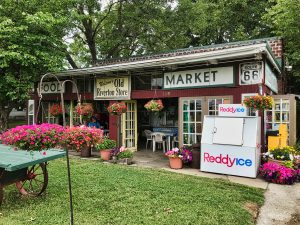
I chose the liver cheese (I’ve always called it liverwurst) sandwich with mayonnaise, tomato and cheddar cheese. Liverwurst is an acquired taste (thanks, mom). I loved it! Bottled water was only 59 cents! We were thrilled to get to talk with the current owner, Mr. Nelson, about the Old Riverton Store.
We drove west from Riverton on Historic Route 66. The Route curves south and we stayed on the old road to visit the Marsh Arch Rainbow Bridge, built in 1923.
BAXTER SPRINGS, KANSAS
With a severe summer storm warning underway, we drove on to Baxter Springs, Kansas. This town is full of history and is the biggest town on the Kansas 66 segment.
One of the most recognized buildings on Kansas 66 is the Tudor-styled Independent Oil & Gas building that was bought by Phillips 66 in 1930. It now serves as the Baxter Springs 66 Station.
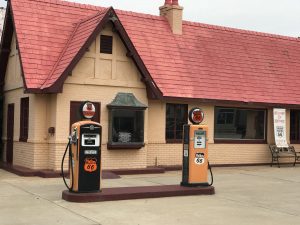
Welcome Center. It served as a gas station through the 1970s and was placed on the National Register of Historic Places in 2003.
BONNIE AND CLYDE IN BAXTER SPRINGS
In 1935, Bonnie and Clyde robbed the Kirkendoll Grocery Store in Baxter Springs twice in seven days! The store was located at 544 West 12th. St. in Baxter Springs. That year, Clyde Barrow was living in Commerce, Oklahoma and waiting for his brother, Buck, to be released from prison in Texas.
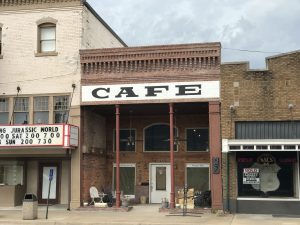
We met an elderly volunteer at the Baxter Springs Heritage Center and Museum who had known the owners of the Kirkendoll Grocery Store (now deceased). He shared this story as related by Ray Kirkendoll, owner of the store.
“I had a horseshoe-type counter in the store made up of a cash and credit register, cigar case, candy and wrapping counter. I knew a store in Tar River had been robbed, so I had taken most of the money out of the cash register and had buried it in the bean bin.
Bonnie and Clyde parked in front of the store. She remained in the car with the door open, smoking a cigarette with a machine gun lying across her lap. Clyde came in with a gun, demanded the money from the register, forced everyone into a backroom and ordered us to lie on the floor. He told us to stay there until he had time to get away. All the time he was cussing me because he only got about $50. He asked me, “Is this all you got?” I answered, “Yes, what do you think we are, a bank?” He didn’t know about the money in the bean bin.
The following week, Barrow sent a young accomplice in first, and then Barrow came in for the second time in a week. Again, he ordered everyone into the back room on the floor. One of the customers that night was Mr. John Hunt. Hunt talked constantly the entire time Clyde was in the store. Barrow took Hunt’s keepsake watch as the accomplice kept Hunt covered with a gun at his back.
Another of my sons, Ray Jr., was in the store the second time and was very frightened, especially because Clyde pointed a gun at the boy and ordered him to empty the cash drawer into a paper sack.
Another customer that night was a young man named Richard Landis. He also was ordered to the backroom to lie on the floor.
After Barrow had left, Landis was still lying on the floor and cussing loudly. I asked him what the shouting was all about and he answered, ” I was so scared, he made me swallow my tobacco!”
Kirkendoll reported that Clyde Barrow was perfectly composed in handling the gun, but his young accomplice was nervous the entire time. He said that during both robberies, Clyde was “cool, cruel and altogether unpleasant.”
GALENA, KANSAS
A part of the approach to Galena, Kansas was once known as “Hell’s Half Acre.“
One of the best known 66 relics in Galena is the old KanOtex service station, now called Cars on the Route. The building is currently used as a snack bar and gift shop.
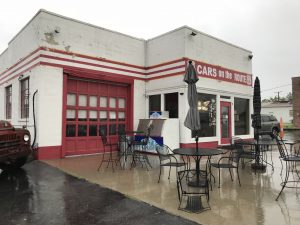
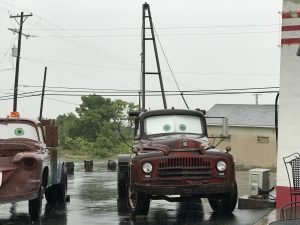
The 1951 International boom truck next to the station inspired the “Tow Mater” character in the movie, Cars. The buildings in Galena inspired the fictional community of Route 66 Radiator Springs, in the same movie.
There is an old Bordello among abandoned buildings in town that testify to days gone by.
On Main Street, is the Howard “Pappy” Litch Park. The small park has a monument to the Will Rogers Highway (Route 66).
The Galena Mining and Historical Museum is just west of Galena.
DECLINE OF ROUTE 66
The decline of Route 66 started in 1956 with the Interstate Highway Act by President Dwight D. Eisenhower. As highway engineering became more sophisticated, engineers found more direct routes to connect cities and towns. Increased vehicular traffic demanded the widening and realigning of the route. Bypasses were built around major towns to allow for increased speed in auto travel.
In 1953, the first major bypass of Route 66 was opened when the Turner Turnpike between Tulsa and Oklahoma City was opened. In 1985, Route 66 was decertified by the American Association of State Highway and Transportation Officials and ceased to exist.
TODAY
Some states have kept the 66 designation for parts of the highway that are state roads. Route 66 Associations were founded in the late 1980s and historic designations of the road followed. In 1999, President Clinton signed a National Route 66 Preservation Bill that provided $10 million in matching fund grants for preserving and restoring historic features along Route 66.
Route 66 is now visited by millions from all over the world. The Mother Road is making a comeback and communities are publicizing and celebrating their location along the historic route. Whether you are interested in the vintage architecture, the historic neon signs along the route, or the nostalgia of the America we left behind, go see Route 66!